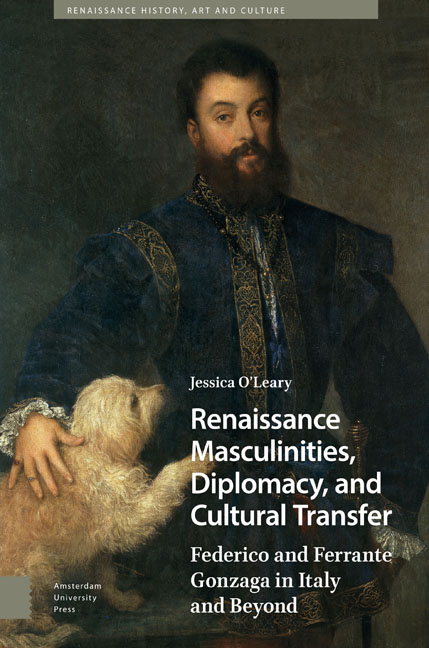 Renaissance Masculinities, Diplomacy, and Cultural Transfer
Renaissance Masculinities, Diplomacy, and Cultural Transfer Book contents
- Frontmatter
- Contents
- Acknowledgements
- Abbreviations
- Maps and Figures
- Introduction
- 1 Crisis Diplomacies in the Italian Wars
- 2 Warring Masculinities
- 3 Imperial Masculinities
- 4 Diplomacy of Magnificence
- 5 Imperial Networks and Loyalties
- 6 Interpretations of Renaissance Masculinities
- Conclusion
- Bibliography
- Index
4 - Diplomacy of Magnificence
Published online by Cambridge University Press: 08 May 2024
- Frontmatter
- Contents
- Acknowledgements
- Abbreviations
- Maps and Figures
- Introduction
- 1 Crisis Diplomacies in the Italian Wars
- 2 Warring Masculinities
- 3 Imperial Masculinities
- 4 Diplomacy of Magnificence
- 5 Imperial Networks and Loyalties
- 6 Interpretations of Renaissance Masculinities
- Conclusion
- Bibliography
- Index
Summary
Abstract
This chapter analyses the ways in which Federico and Ferrante Gonzaga made space, literally and figuratively, for the Spanish Habsburgs in Italy. In 1530, Charles V visited Italy and travelled to Mantua where he was entertained in lavish conditions by Federico Gonzaga, then marquis of Mantua. The expensive displays were designed to present the city as a loyal, and prestigious, ally to the Emperor. Similarly, in 1549, Charles V's heir apparent Philip II visited Milan, then governed by Ferrante Gonzaga, in addition to Mantua. These and other festivities, such as Ferrante's entrance to Sicily in 1535, provide vital clues as to how local Italians reconciled the Spanish conquest of traditionally independent territories with their own sense of national identity.
Keywords: Gonzaga, Cultural Exchange, Triumphal Entry, Patronage, Renaissance Festivals
On February 24, 1530, on his thirtieth birthday, Charles V was crowned Emperor of the Holy Roman Empire by Pope Clement VII in the San Petronio Basilica in Bologna. The coronation was a watershed moment in Imperial– Papal relations, following the nadir of the Sack of Rome in 1527 and eventual rapprochement after the conclusion of the Treaty of Cambrai in August 1529. In the following months, Clement VII negotiated the restoration of his Medici relatives to Florence and, in exchange, agreed to crown Charles in Rome. Charles must have imagined a splendid coronation at St Peters Basilica followed by a triumphant descent to Naples to celebrate his rule. However, such plans came to nought. In late September 1529, Suleiman I attacked the city of Vienna with over 100,000 soldiers in a two-and-a-half-week-long siege. Although the Habsburg stronghold withstood the Ottoman attack, the damage to imperial resolve was palpable. Charles V moved the coronation to the northern city of Bologna, so that he, and his troops, could move quickly to central Europe if necessary to assist his brother, Ferdinand. However, before travelling to Vienna, he spent a month in Mantua in the company of Federico Gonzaga, who lavished his important guest with sumptuous banquets, excellent hunting expeditions, and visits to the famed Palazzo Te.
- Type
- Chapter
- Information
- Renaissance Masculinities, Diplomacy, and Cultural TransferFederico and Ferrante Gonzaga in Italy and Beyond, pp. 127 - 160Publisher: Amsterdam University PressPrint publication year: 2024
